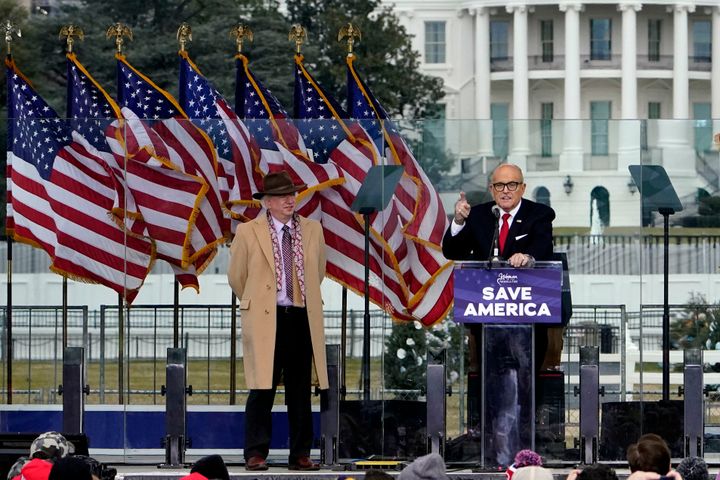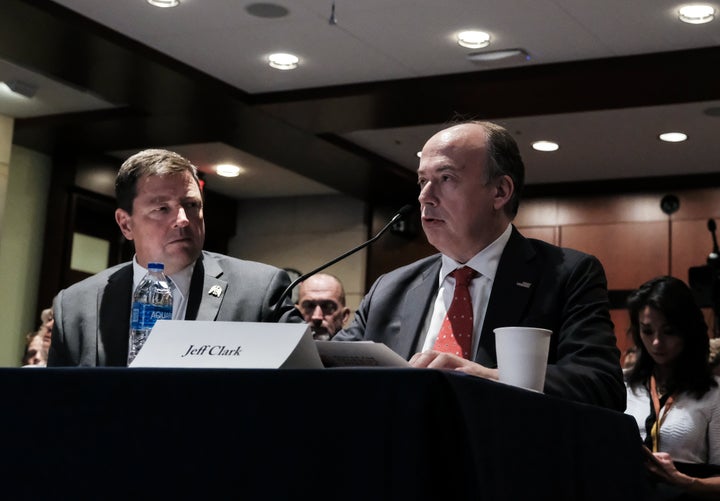Former President Donald Trump was aided by six co-conspirators in his plot to steal the 2020 election, according to his indictment by the Department of Justice filed on Tuesday.
Trump was indicted on four felony counts for his efforts to overturn his 2020 election loss, culminating in the insurrection at the U.S. Capitol on Jan. 6, 2021. The charges Trump faces include engaging in a conspiracy to defraud the government, a conspiracy to obstruct the Jan. 6 certification of electoral votes, and a conspiracy against the right to have one’s vote counted.
The indictment does not name the six alleged co-conspirators, but their identities are revealed through details and information provided within. Below are the identities of the six people described as co-conspirators in the indictment:
Co-Conspirator 1: Rudy Giuliani
This person is listed as “an attorney who was willing to spread knowingly false claims and pursue strategies that the Defendant’s 2020 re-election campaign attorneys would not.”
Aside from the description, the indictment provides additional information showing that Rudy Giuliani, Trump’s lawyer and the former mayor of New York City, is Co-Conspirator 1. It states that Trump selected Co-Conspirator 1 on Nov. 14, 2020, to “spearhead his efforts going forward to challenge the election results.” Trump named Giuliani to lead these efforts on that date, according to news reports at the time.
The indictment also recounts a phone call that Trump and Co-Conspirator 1 made to then-Arizona House Speaker Rusty Bowers on Nov. 22, 2020, to pressure him to help them steal the election. It also states that Co-Conspirator 1 met with Bowers on Dec. 1 of that year. Co-Conspirator 1 is quoted in the indictment telling Bowers, “We don’t have evidence, but we have lots of theories.”
Bowers later recounted the pressure that Trump and Giuliani put on him in both the phone call and meeting.
“In my recollection, he said, ‘We have lots of theories, we just don’t have the evidence,’” Bowers testified to the House Jan. 6 committee.
Co-Conspirator 2: John Eastman
The second alleged co-conspirator is “an attorney who devised and attempted to implement a strategy to leverage the Vice President’s ceremonial role overseeing the certification proceeding to obstruct the certification of the presidential election.”

John Eastman, a right-wing lawyer who came up with the legal argument that the vice president can unilaterally decide an election’s result, is, like Giuliani, identifiable through the pressure he applied to Bowers.
The indictment recounts a Jan. 4, 2021, phone call where Co-Conspirator 2 pressured Bowers to decertify Arizona’s legitimate election results favoring Joe Biden to help Trump steal the election. When Bowers said there was no evidence of fraud and he wouldn’t decertify, Co-Conspirator 2 told him to just “let the courts sort it out.”
The date of the phone call and the quote are identical to what Bowers told the Jan. 6 committee about speaking to Eastman.
Co-Conspirator 3: Sidney Powell
The indictment says that the third alleged co-conspirator is “an attorney whose unfounded claims of election fraud the Defendant privately acknowledged to others sounded ‘crazy.’ Nonetheless, the Defendant embraced and publicly amplified Co-Conspirator 3’s disinformation.”
It has long been reported that Trump called Sidney Powell ― a conspiratorial liar who aimed to be appointed special counsel to investigate imaginary voter fraud ― “crazy,” but continued to seek her counsel. In addition, the indictment states that Co-Conspirator 3 filed a lawsuit challenging “massive election fraud” in Georgia based on falsehoods about voting machines. This lawsuit was Powell’s “Kraken” suit that was ultimately tossed by a judge as baseless and led to sanctions and defamation civil suits against Powell.
Co-Conspirator 4: Jeffrey Clark
Former Justice Department official Jeffrey Clark, then serving as acting head of DOJ’s civil division, is the only person who fits the description of “a Justice Department official who worked on civil matters and who, with the Defendant, attempted to use the Justice Department to open sham election crime investigations and influence state legislatures with knowingly false claims of election fraud.”
Clark attempted to have himself installed as acting attorney general so that he could initiate fake investigations into non-existent voter fraud in order to help Trump steal the election. He was thwarted in an Oval Office showdown where the entire senior leadership of the Justice Department threatened to resign if Trump appointed Clark.

Michael A. McCoy via Getty Images
Co-Conspirator 5: Kenneth Chesebro
The fifth alleged co-conspirator is said to be “an attorney who assisted in devising and attempting to implement a plan to submit fraudulent slates of presidential electors to obstruct the certification proceeding.”
The Jan. 6 committee report identified Chesebro as the architect of the plan to have GOP electors submit fake slates to Congress as part of a plan to get Vice President Mike Pence to reject the legitimate electors for Biden. The indictment states that Co-Conspirator 5 talked to and emailed with an “Arizona attorney” on Dec. 8, 2020, to explain the plot.
“His basic idea is that all of us (GA, WI, AZ, PA, etc.) have our electors send in their votes (even though the votes aren’t legal under federal law – because they’re not signed by the governor,” the Arizona attorney wrote in an email to GOP political consultants and lawyers summarizing Co-Conspirator 5’s pitch.
That Arizona attorney was previously identified by the New York Times as Jack Wilenchik. The same article notes that Wilenchik spoke to Chesebro on Dec. 8.
The indictment also notes that Co-Conspirator 5 wrote the Dec. 9, 2020, memo that provided instructions on “how fraudulent electors could mimic legitimate electors in Arizona, Georgia, Michigan, Nevada, Pennsylvania, and Wisconsin.” Chesebro is the author of that memo.
Co-Conspirator 6: Unclear
The sixth alleged co-conspirator is said to be “a political consultant who helped implement a plan to submit fraudulent slates of presidential electors to obstruct the certification proceeding.”
This is the one listed co-conspirator whose identity is not immediately obvious. Aside from the description, the indictment states that Giuliani “spoke with Co-Conspirator 6 regarding attorneys who could assist in the fraudulent elector effort in the targeted states.” Co-Conspirator 6 then provided a list of attorneys in Arizona, Georgia, Michigan, Nevada, New Mexico, Pennsylvania and Wisconsin, according to the indictment. Chesebro then used that list to contact Wilenchik, as the Times reported.
Later on Dec. 13, the day before the real electors were required to certify their state election results, Giuliani and Co-Conspirator 6 joined a Trump “Senior Campaign Advisor” on a phone call to debrief them on the fake elector plot, the indictment states. This call was later recounted in an email to other Trump campaign advisors as having “morphed [into] a crazy play so don’t know who wants to put their name on it.”

